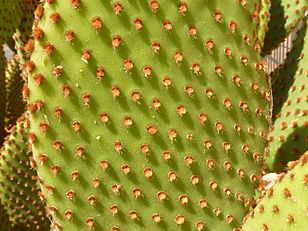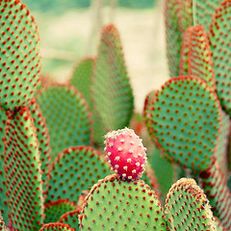Blind prickly pear facts for kids
Quick facts for kids Blind prickly pear |
|
|---|---|
 |
|
| Conservation status | |
| Scientific classification | |
| Genus: |
Opuntia
|
| Species: |
rufida
|
The Opuntia rufida is a special kind of prickly pear cactus. It grows naturally in southwestern Texas and northern Mexico. You can often find it on rocky hillsides.
This cactus is unique because it doesn't have sharp spines like many other cacti. Instead, it has lots of tiny, reddish-brown bristles called glochids. These glochids are very small and can easily come off.
The plant is sometimes called the blind prickly pear or cow blinder. This is because its tiny glochids can be carried by the wind. If they get into the eyes of animals, they can cause temporary blindness.
Opuntia rufida is closely related to another cactus called Opuntia microdasys. Sometimes, people even consider it a subspecies of O. microdasys, known as O. m. subsp. rufida. A popular type sold in nurseries is called Opuntia Rufida Minima Monstrose.
Contents
What Does the Blind Prickly Pear Look Like?
The Opuntia rufida is a cactus that grows many branches. It can reach about 3 to 5 feet (around 1 to 1.5 meters) tall and even wider. It usually has a short main stem.
Its pads, which are like thick, flat leaves, are round, oval, or shaped like an egg. These pads feel a bit fuzzy. The small bumps on the pads, called Areoles, don't have spines. But they do have those noticeable reddish-brown glochids.
In the middle of spring, this cactus puts on a beautiful show. It produces many bright yellow flowers that change to orange and red. These flowers are quite large, about 3 to 4 inches (7 to 10 cm) across. Later in the summer, the plant grows oblong fruits. These fruits are bright red to purple and are about 2 to 3 inches (5 to 7.5 cm) long.
This cactus can be a stunning plant for a desert garden. It needs lots of sunshine and can handle the hot desert weather very well. However, remember that the glochids can easily come off if the plant is touched or shaken. They can be harmful to people and animals if they become airborne. The name rufida actually means "ruddy" or "reddish-brown," referring to the color of its glochids.
Where Does the Blind Prickly Pear Grow?
Opuntia rufida naturally grows in the Big Bend area of southwestern Texas. It also grows in the Chihuahuan Desert region of northern Mexico.
Where It Has Been Planted
This cactus has also been planted in Queensland, Australia, as an ornamental plant. This means people planted it because it looks nice. However, it has since been identified as a Prohibited invasive plant under the Biosecurity Act 2015.
This means that in Queensland, Australia, it is now against the law to sell or move this plant. If someone finds it, they must report it to Biosecurity Queensland. This rule helps protect the local environment from plants that can spread too much and harm native species.
Gallery
See also
 In Spanish: Opuntia rufida para niños
In Spanish: Opuntia rufida para niños






